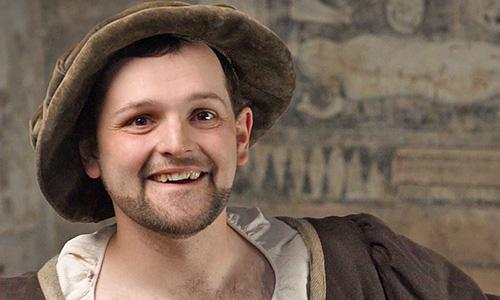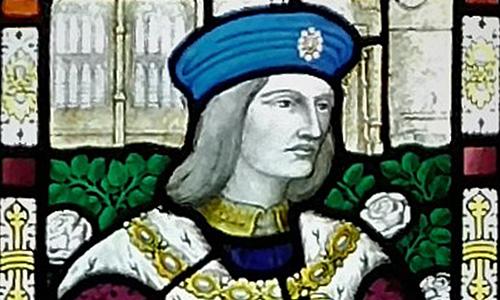Hugh Clopton’s Bridge
Visiting Stratford-upon-Avon today often requires the traveller to cross ‘Clopton Bridge’, thought to have been named after one of its builders, Hugh Clopton (1440-1496) - the younger son of a local manorial family. As the younger son, Hugh left Stratford-upon-Avon for London, where he rose through the ranks of the Worshipful Company of Mercers to become Lord Mayor of London.
Having no family, he devoted much of his fortune to charitable works. It was common in the middle ages for structures such as bridges to be funded or endowed by wealthy donors or institutions like guilds, much as churches or schools were. The fine stone bridge replaced an earlier timber bridge which is thought to have been replaced largely at Clopton’s expense, during his lifetime.
Why is the bridge where it is?
Stratford-upon-Avon takes its name from the old English Streat – a paved, usually Roman Road, and ford. The site of Clopton’s bridge is one of four fords between Lucy Mill by the modern bridge over the Avon downstream and Tiddington upstream where there was a Romano-British settlement. The Romans chose the site of Clopton’s bridge for the ford on their road linking the important Fosse Way to the Roman Fort at Alcester, so this has been an important route since the first century AD.
The Clopton connection
The Bishop of Worcester held the manor of Stratford at Domesday, and established the borough of Stratford-upon-Avon in 1196. The earliest records of the wooden bridge on the site date back to 1235, when a certain Richard was known as the Bridge Keeper. There was a chapel dedicated to St Mary Magdalene at the south end of the bridge and a hermitage, possibly on the site of the Swan’s Nest Hotel. By 1269 the bridge was being described as the ‘Great Bridge’. A century later, in 1363 William de Buntanesdale and William del Cley obtained a grant of ‘pontage’ for three years for the repair of the bridge which was broken down.
While cheaper to build than stone bridges, especially with a ready supply of timber from the Forest of Arden north of Stratford, crossing a wooden bridge was not for the faint hearted. The sixteenth-century antiquarian, John Leland, noted that it was Hugh Clopton who ‘converted a great peace of his substance in good works in Stratford, first making a sumptuous new bridge and large of stone’, adding that, ‘Afore the time of Hugh Clopton there was but a poor bridge of timber and no causey to it, whereby many poor folks and other refused to come to Stratford when the river was up or coming thither stood in jeopardy of life’.
As a merchant, Clopton would have known the value of bridges to trade and commerce, and in his will of 1496, he left money for the maintenance and repair of other bridges and causeways between Stratford-upon-Avon and London. This reinforces Leland’s suggestion that Clopton paid for the bridge during his lifetime, probably by the time he was made Lord Mayor of London 1491. This would not have been a cheap undertaking! Records of the whole cost of medieval bridge-building are scarce, but a comparable - and eye-wateringly expensive - example would be the fifteenth-century bridge built by the Abingdon Guild of the Holy Cross in Oxfordshire.
The bridge we see today spans the main flow of the river for 140m, not the flood plain which stretches for a further 200m. Four of the arches of what was once an eighteen-arch bridge form part of the causeway on the north side of the river. It was common for medieval bridges to fail when rivers flooded, particularly wooden bridges. Wooden bridges could also catch fire, and Stratford-upon- Avon suffered serious fires in 1594 and 1595, and again in 1614 and 1641. In a period in which most of Stratford’s houses were timber-framed and thatched, the bridge would have been an impressive addition to the town’s other monumental buildings - the parish church, the Guild Chapel and Clopton’s brick-built house. Contemporaries must really have felt that Clopton had put Stratford-upon-Avon on the map as an attractive place to travel to and do business.
Why was the bridge important?
When the Bishop of Worcester laid out Stratford from 1196 onwards, an ambitious grid pattern was established for Stratford centred on Bridge Street. To prosper, the town needed an axis across the Avon to the site of the junction of roads to the south – Banbury and Shipston. Sheep from the Cotswolds presumably crossed the bridge to the market in Sheep Street. Grain was brought up from the Feldon area and timber products would also have been brought in from the Forest of Arden to the north. A fascinating side note is that, as a member of the London mercers, Hugh Clopton would have had the right to drive a flock of sheep across London Bridge without toll - a right that is still preserved in the City of London today!
Of course, rivers presented a significant obstacle and so were of strategic importance not just for trade, but also in times of conflict. During the English Civil War (1642-51), the Parliamentarian forces destroyed one of the arches at Clopton Bridge – on the orders of the wonderfully-named Colonel Bridges. Royalists did the same downstream at Bidford bridge.
How was the bridge maintained?
Tolls, taxes and rents were important factors in supporting the maintenance of the earlier wooden bridge and Clopton’s stone structure. Records for grants of what was called ‘pontage’ for repairs to the bridge date back to 1363, whilst income from land associated with the nearby hermitage was also confirmed as being for the repair of the bridge in 1444. Further income was also derived from grants of property - by John Halle & Hook Norton in the 1490s.
By 1524, there were four annually-elected Bridge Wardens - who had close links to the Guild of the Holy Cross and who were coordinating funds from endowments and organising the Annual Bridge Ale event – a form of bring-and-buy sale to ensure its upkeep of the bridge. In 1524 two arches were rebuilt at a cost of £8. On Ascension Day (a Christian feast held 40 days after Easter), the wardens organised the St George and Dragon Pageant - complete with an armour-clad St George and a fire-breathing dragon! This raised money for St George’s altar in the parish church, as well as the clocks at the Guild Chapel and Market Cross.
In 1553, when the Corporation of Stratford-upon-Avon received its charter, the preamble noted that the Guild had been responsible for the maintenance of the bridge and they were awarded an annual rent of £3 6s and 8d was awarded from the income of the former guild estates. By 1616 the corporation had assumed full responsibility for the bridge and two aldermen were chosen annually as bridge wardens.
Even stone bridges needed constant maintenance and by the seventeenth century, the Corporation were sometimes paying up to £70 annually towards its repair. Bridges were often built with shallow foundations which could suffer from scour, where flow through an arch undermines foundations. The southernmost arch has a locally well-known ‘eddy’ effect when the river is high, creating a reverse flow upstream dangerous to swimmers. It has been suggested that Shakespeare’s youthful enthusiasm for river sports gave him the experience to write with first hand knowledge of the perils of swimming in turbulent waters!
How has the bridge changed since Clopton’s time?
In Clopton’s time we would have seen a narrower bridge and a further five more arches supporting the causeway across the flood plain to the foot of Bridge Street. The parapets of the bridge would also have been much lower, only about 4-5 inches (10-13cms) high, and were raised in 1696.
What is now Bancroft would often be flooded, and later records note that people were sometimes trapped on the bridge – which effectively became an island surrounded by flood water. On 11th July 1588 for example, ‘Three men going over it [the bridge] reached the middle and could not go forwards and returning could not go back the water was so risen’. Did these kinds of accounts inspire William Shakespeare, perhaps, when he wrote about storms, wind and rain in so many of his plays?
The navigability of the Avon was commented on by later travel writers such as Daniel Defoe (1724-7) but by the end of the eighteenth century, there had been a substantial increase in traffic along the turnpike roads, with the Stratford Alcester Bromsgrove Turnpike Act passed in 1753.
The bridge was widened in 1812 and a Toll House built in 1814 by the newly-constituted Bridge Commissioners who were also given permission to demolish property on the approach to the bridge. The canal basin was built in 1816 and the cast iron footway added to the bridge in 1827. A tramway bridge, a little further down-stream on the River Avon, was built in 1828 - this affords the best views of Clopton’s original medieval bridge without the later additions.
Bridge Street itself had a middle row, which was not fully demolished until 1857, having been proposed for demolition as early as 1830.
The Bridge today
Clopton’s Bridge remains strategically important to traffic flows within Stratford-upon-Avon for residents and visitors alike. In the last 100 years or so there have been many proposals to change and improve traffic flows with concerns that the bridge was too narrow for modern traffic.
That started with concerns over perambulators crossing the bridge, but from the 1920’s through to the 1960’s various schemes proposed re-siting this important north south route, or widening further the existing bridge. While an upstream diversion of the main traffic flow leaving the bridge for pedestrians only could have preserved the original character of the bridge, schemes to widen or add an adjoining modern bridge would have detracted from Clopton’s masterpiece.
It is a tribute to Clopton and the medieval bridge builders that in essence the bridge survives and continues to serve the town after 530 years.
Further reading
- Robert Bearman (1997) The History of an English Borough Stratford-upon-Avon 1196-1996 (Stroud (Gloucs): Sutton Publishing)
- Martin Cook (1998) Medieval Bridges (Princes Risborough: Shire Publications)
- Paul Edmondson, Kevin Colls and Will Mitchel (2016) Finding Shakespeare’s New Place: an archaeological biography (Manchester: Manchester University Press)
- David Harrison (2004) The Bridges of Medieval England (Oxford: Oxford University Press)
- Maurice Ribbans (2005) Clopton Bridge - A Short history of the Gateway to Stratford-upon-Avon (Atlanta: Lulu Publishing)
- Philip Styles (ed.) (1945) ‘The borough of Stratford-upon-Avon: Introduction and architectural description’, in The Victoria History of the County of Warwick: Volume 3, Barlichway Hundred (London: HMSO), pp.221-234.










